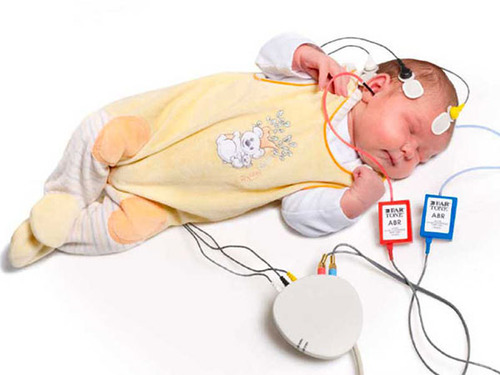Brainstem Auditory Evoked Responses (BERA)
What is BERA test?
The BERA test measures the reaction of the parts of a child’s nervous system that affect hearing. The ABR test measures the auditory nerve’s response to sounds. It performed if a newborn or infant fails the hearing screening test given in the hospital shortly after birth, or for older children if there is a suspicion of hearing loss that was not confirmed through more conventional hearing tests.
- The BERA test is safe and does not hurt.
- The BERA test can be completed only if the child is sleeping or lying perfectly still, relaxed and with his or her eyes closed.
- If your child is younger than 6 months of age, the ABR test usually can be done while he or she naps.
- If your child is older than 7 years, the BERA test usually can be done while your child is awake if he or she can relax and lie still. The test will be done in a special sound-treated suite in the Audiology department.
- For children between the ages of 6 months and 7 years, the ABR test is done under anesthesia, which means that your child will need medication to help him or her sleep throughout the test. ABR tests with anesthesia are done through the Same Day Surgery Center.
- When anesthesia is needed, there are special rules for eating and drinking that must be followed in the hours before the test. If these rules are not followed, the test cannot be done that day.
- When the test is done under anesthesia, your child’s primary care provider will need to see your child for a physical to fill out a history and physical form.
- The test itself takes about 1 hour to 11/2 hours, but the entire appointment will take about 2 hours without anesthesia and up to 4 hours if your child needs anesthesia, due to the recovery time.
How is it done?

The BERA is a helpful tool in determining a child’s ability to hear. The test uses a special computer to measure the way the child’s hearing nerve responds to different sounds.
Three to four small stickers called “electrodes” will be placed on your child’s head and in front of his or her ears and connected to a computer. As sounds are made through the earphones, -the electrodes measure how your child’s hearing nerves respond to them.
The audiologist, or hearing specialist, looks for certain neurological “markers” as your child’s hearing nerves respond to sounds. The softest intensity or loudness level at which these markers appear roughly corresponds to the child’s hearing level in that frequency range or pitch. By reading a computer printout of your child’s responses and interpreting these markers, the audiologist can tell if your child has a hearing problem.

Otoacoustic emissions (OAE)
Otoacoustic Emission (OAE) Screening is used widely in hospital-based newborn hearing screening programs. Portable OAE screening is the most practical method for screening infants and toddlers.
The procedure is performed with a portable handheld screening unit. A small probe is placed in the child’s ear canal. This probe delivers a low-volume sound stimulus into the ear. The cochlea responds by producing an otoacoustic emission, sometimes described as an “echo,” that travels back through the middle ear to the ear canal and is analyzed by the screening unit. In approximately 30 seconds, the result is displayed on the screening unit as a “pass” or a “refer.”
Otoacoustic emissions (OAE) screening can help to detect sensorineural hearing loss occurring in the cochlea. It can also call attention to hearing disorders affecting the pathway to the inner ear.
Protocol –

- An initial screening of both ears on every child (at birth)
- Any ear not passing the initial (1st OAE) screening is screened again (2nd OAE) within approximately 2 weeks of the first screen, if the first screen shows refer.
- If the ear does not pass the 2nd OAE screen, the child must be evaluated by ENT specialist.
- If the ear does not pass the OAE rescreen, the child should be referred for further confirmatory tests like BERA.
